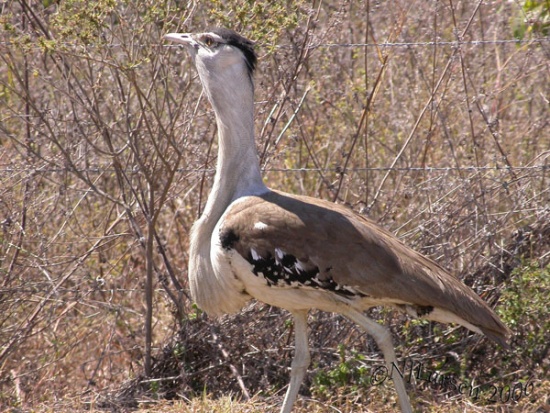(User template. References given for copied text) |
(Attempt at cleaning up the page/ add misc) |
||
| Line 1: | Line 1: | ||
| − | [[Image:Australian_Bustard.jpg|thumb|550px|right|Photo by {{user|njlarsen|njlarsen}}<br />near Mt. Molloy]] | + | [[Image:Australian_Bustard.jpg|thumb|550px|right|Photo of a male by {{user|njlarsen|njlarsen}}<br />near Mt. Molloy]] |
;[[:Category:Ardeotis|Ardeotis]] australis | ;[[:Category:Ardeotis|Ardeotis]] australis | ||
==Identification== | ==Identification== | ||
| − | Male - 1.2 m; female 80cm. | + | Male - 1.2 m; female 80cm. At a distance seen as a mostly pale bird with browner upperside. Closer up, one will notice dark crown (black in male, brown in female), black band across lower breast, and black-white spotting along lower edge of wing. Male will display will inflate a breast sac with white feathers so that this reaches the ground, and fan the tail over the back. |
| + | In fligth looks heavy with slow wing beats and feet protruding behind the tail. I is probably more likely to try to walk away than to fly away from danger. | ||
==Distribution== | ==Distribution== | ||
Lowlands of [[Australia]] (except southwestern/eastern) and southern [[New Guinea]]. | Lowlands of [[Australia]] (except southwestern/eastern) and southern [[New Guinea]]. | ||
==Taxonomy== | ==Taxonomy== | ||
| − | + | This is a monotypic species<sup>[[#References|[1]]]</sup>. | |
==Habitat== | ==Habitat== | ||
| − | + | Scrubby areas, spinifex, grasslands and grass-woodland. | |
==Behaviour== | ==Behaviour== | ||
| − | The diet includes leaves, buds, seeds, fruit, frogs, lizards, and invertebrates. | + | In feeding, the Australian Bustard will avoid the heat of mid day. The diet includes leaves, buds, seeds, fruit, frogs, lizards, and invertebrates. Can be abundant around swarms of grasshoppers, or where house mice are common. |
| − | + | Male in display will inflate a breast sac with white feathers so that this reaches the ground, and fan the tail over the back. In breeding, one to three eggs get laid on the ground, no proper nest is made. The female sits on the egss and cares for the young. | |
| + | This species is nomadic and partly migratory, leading to it being found further south in summer and north in winter. | ||
==References== | ==References== | ||
| − | + | # Clements, James F. 2007. ''The Clements Checklist of Birds of the World''. 6th ed., with updates to October 2007. Ithaca: Cornell University Press. ISBN 9780801445019 | |
| + | # Pizzey, G. & Knight, F. 1997. Birds of Australia (Collins Field Guide). HarperCollins Publishers, London. ISBN 0-00-220132-1 | ||
| + | |||
==External Links== | ==External Links== | ||
{{GSearch|Ardeotis+australis}} | {{GSearch|Ardeotis+australis}} | ||
[[Category:Birds]][[Category:Ardeotis]] | [[Category:Birds]][[Category:Ardeotis]] | ||
Revision as of 02:05, 19 January 2009
- Ardeotis australis
Identification
Male - 1.2 m; female 80cm. At a distance seen as a mostly pale bird with browner upperside. Closer up, one will notice dark crown (black in male, brown in female), black band across lower breast, and black-white spotting along lower edge of wing. Male will display will inflate a breast sac with white feathers so that this reaches the ground, and fan the tail over the back.
In fligth looks heavy with slow wing beats and feet protruding behind the tail. I is probably more likely to try to walk away than to fly away from danger.
Distribution
Lowlands of Australia (except southwestern/eastern) and southern New Guinea.
Taxonomy
This is a monotypic species[1].
Habitat
Scrubby areas, spinifex, grasslands and grass-woodland.
Behaviour
In feeding, the Australian Bustard will avoid the heat of mid day. The diet includes leaves, buds, seeds, fruit, frogs, lizards, and invertebrates. Can be abundant around swarms of grasshoppers, or where house mice are common.
Male in display will inflate a breast sac with white feathers so that this reaches the ground, and fan the tail over the back. In breeding, one to three eggs get laid on the ground, no proper nest is made. The female sits on the egss and cares for the young.
This species is nomadic and partly migratory, leading to it being found further south in summer and north in winter.
References
- Clements, James F. 2007. The Clements Checklist of Birds of the World. 6th ed., with updates to October 2007. Ithaca: Cornell University Press. ISBN 9780801445019
- Pizzey, G. & Knight, F. 1997. Birds of Australia (Collins Field Guide). HarperCollins Publishers, London. ISBN 0-00-220132-1




